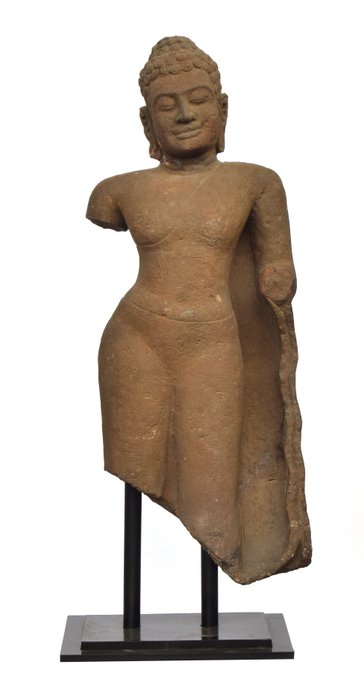
Selyúcida plato de bronce (Sin Precio de Reserva)
N.º 87040309

N.º 87040309

Buddha Sculpture
- Very Nice Quality -
- Important Piece! -
Khmer, Cambodia, 12th century AD.
Sandstone.
135 x 50 x 25 cm.; 154 cm. height with the stand.
Condition: Good condition. See photos.
Provenance: Private collection, Birdport, UK. 1970.
Description:
The piece represents a young male body that stands out for the sobriety and elegance of its conception. The sculptor has marked the body features, such as the beautifully rounded pectorals. But it is above all on the head that the greatest number of details is concentrated, characterized by several lakshana or symbolic signs specific to the plastic representation of Buddhas and bodhisattvas: serene smile and closed eyelids, symbol of spiritual concentration; elongated earlobes, which allude to the large earrings worn by members of the upper classes and represent the concepts of greatness, nobility and wisdom. And finally, the headdress, inspired by the shape of a pagoda.
The Khmer Empire was the largest empire in Southeast Asia and its core roughly corresponded to present-day Cambodia. The empire, which had gained independence from the kingdom of Srivijaya and eventually replaced the kingdom of Chenla, controlled or made vassals of present-day Malaysia, Thailand, Laos, Vietnam, Myanmar and Indonesia. During the formation of the empire, the Khmer Empire had very close cultural, political and commercial ties with Java first and with Srivijaya, which were located in the south of the empire. Its most important legacy is Angkor, which was the capital of the empire during its heyday. Angkor is the best testimony of the power and wealth of the empire, as well as the diversity of beliefs that followed one another over the centuries. The official religions of the empire were Hinduism and Mahayana Buddhism until Theravada Buddhism took over after its introduction from Sri Lanka in the 13th century. Modern satellites have revealed that Angkor was the largest pre-industrial human settlement in the world, larger than modern New York and all. The history of Angkor as the center of the historic kingdom of Kambuja is also the history of the Khmer Empire from the 9th to the 15th century.
Notes:
- The piece includes authenticity certificate.
- The piece includes Spanish Export License (Passport for European Union) - If the piece is destined outside the European Union a substitution of the export permit should be requested, can take between 1-2 weeks maximum.
- The seller guarantees that he acquired this piece according to all national and international laws related to the ownership of cultural property. Provenance statement seen by Catawiki.
#masterpieces
Cómo comprar en Catawiki
1. Descubre algo especial
2. Haz la puja más alta
3. Paga de manera segura